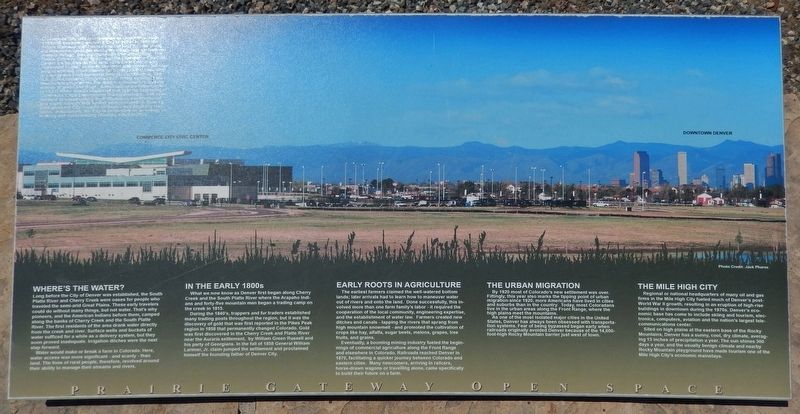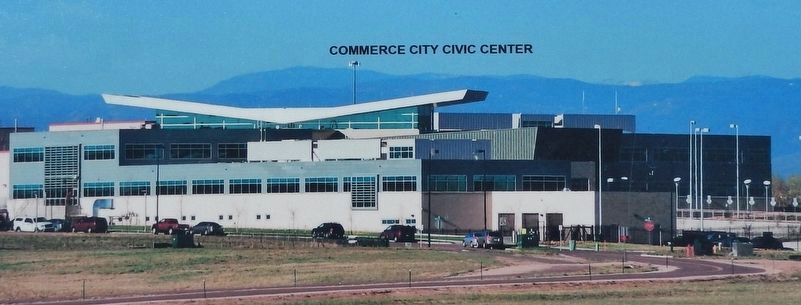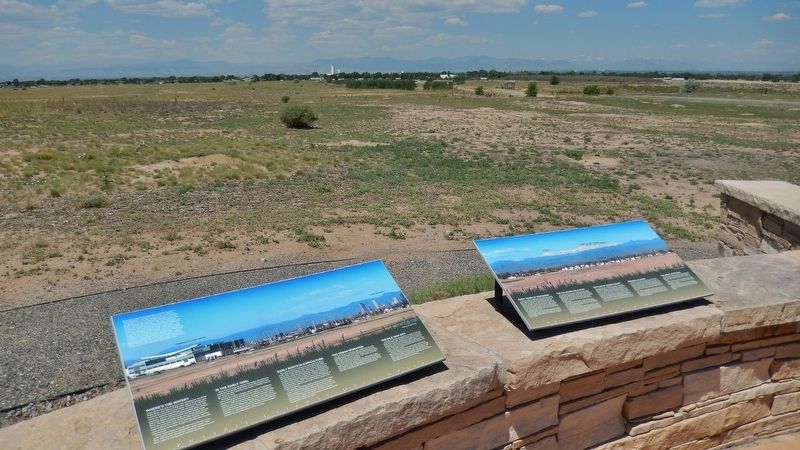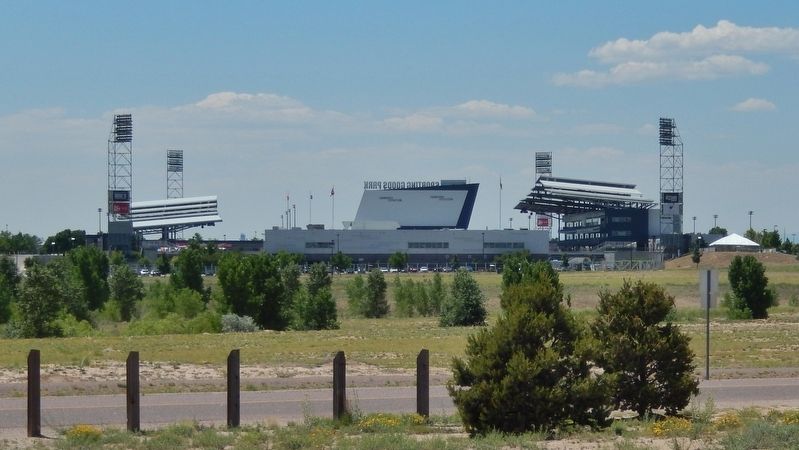Commerce City in Adams County, Colorado — The American Mountains (Southwest)
Where's the Water?
Commerce City
Commerce City was incorporated as Commerce Town in 1952 and became Commerce City in 1970. In 2004 the Prairie Gateway, a 917-acre parcel of land located along the western edge of the Rocky Mountain Arsenal National Wildlife Refuge, was purchased by Commerce City. The Prairie Gateway Open Space and the Commerce City Civic Center are located on this land. The Civic Center was completed in 2007 and was designed and constructed consistent with the requirements for Silver LEED (Leadership in Energy and Environmental Design) Certification. The U.S. Green Building Council's LEED rating system is the preeminent program for the design, construction and operation of green buildings. Constructing the Civic Center to LEED Silver design standards was just the beginning of Commerce City's commitment to sustainability. The commitment to sustainability from economic, environmental and social aspects was further demonstrated on June 15, 2009 when the City Council adopted a sustainability resolution. Additionally, the City is embarking on an energy efficiency and sustainability planning effort in 2009.
Where’s the Water?
Long before the City of Denver was established, the South Platte River and Cherry Creek were oases for people who traveled the semi-arid Great Plains. These early travelers could do without many things, but not water. That's why pioneers, and the American Indians before them, camped along the banks of Cherry Creek and the South Platte River. The first residents of the area drank water directly from the creek and river. Surface wells and buckets of water sufficed for a while as a delivery system, but they soon proved inadequate. Irrigation ditches were the next step forward.
Water would make or break a farm in Colorado. Here, water access was more significant - and scanty - than land. The lives of rural people, therefore, revolved around their ability to manage their streams and rivers.
In the Early 1800s
What we now know as Denver first began along Cherry Creek and the South Platte River where the Arapaho Indians and forty-five mountain men began a trading camp on the creek in 1815.
During the 1840's, trappers and fur traders established many trading posts throughout the region, but it was the discovery of gold that was first reported in the Pikes Peak region in 1858 that permanently changed Colorado. Gold was first discovered in the Cherry Creek and Platte River near the Auraria settlement, by William Green Russell and his party of Georgians. In the fall of 1858 General William Larimer, Jr. claim jumped the settlement and proclaimed himself the founding father of Denver City.
Early Roots in Agriculture
The
earliest farmers claimed the well-watered bottom lands; later arrivals had to learn how to maneuver water out of rivers and onto the land. Done successfully, this involved more than one farm family's labor - it required the cooperation of the local community, engineering expertise, and the establishment of water law. Farmers created new ditches and canals - tapping the rivers that sprang from high mountain snowmelt - and promoted the cultivation of crops like hay, alfalfa, sugar beets, melons, grapes, tree fruits, and grains.
Eventually, a booming mining industry fueled the beginnings of commercial agriculture along the Front Range and elsewhere in Colorado. Railroads reached Denver in 1870, facilitating a quicker journey between Colorado and eastern cities. Many newcomers, arriving in railcars, horse-drawn wagons or travelling alone, came specifically to build their future on a farm.
The Urban Migration
By 1920 most of Colorado's new settlement was over. Fittingly, this year also marks the tipping point of urban migration - since 1920, more Americans have lived in cities and suburbs than in the country. Today, most Coloradans live in the urban areas along the Front Range, where the high plains meet the mountains.
As one of the most isolated major cities in the United States, Denver has always been obsessed with transportation systems. Fear of being
bypassed began early when railroads originally avoided Denver because of the 14,000-foot-high Rocky Mountain barrier just west of town.
The Mile High City
Regional or national headquarters of many oil and gas firms in the Mile High City fueled much of Denver's post-World War II growth, resulting in an eruption of high-rise buildings in downtown during the 1970s. Denver's economic base has come to include skiing and tourism, electronics, computers, aviation and the nation's largest telecommunications center.
Sited on high plains at the eastern base of the Rocky Mountains, Denver has a sunny, cool, dry climate, averaging 13 inches of precipitation a year. The sun shines 300 days a year, and the usually benign climate and nearby Rocky Mountain playground have made tourism one of the Mile High City's economic mainstays.
Erected by Commerce City, Great Outdoors Colorado, and Adams County Open Space.
Topics. This historical marker is listed in these topic lists: Agriculture • Environment • Settlements & Settlers • Waterways & Vessels.
Location. 39° 48.73′ N, 104° 53.475′ W. Marker is in Commerce City, Colorado, in Adams County. Marker can be reached from Gateway Road, 0.7 miles north of Prairie Parkway (East 64th Avenue), on the left when traveling east. Marker is located in an open kiosk, overlooking Commerce City to the south, Denver to the west, and Thornton to the north. The kiosk is a central welcoming point for Commerce City's Prairie Gateway Open Space Park. Touch for map. Marker is in this post office area: Commerce City CO 80022, United States of America. Touch for directions.
Other nearby markers. At least 8 other markers are within 2 miles of this marker, measured as the crow flies. Early Years of Statehood (here, next to this marker); Habitat for Wildlife - A Rich History (a few steps from this marker); The Fourteeners (a few steps from this marker); Rocky Mountain Arsenal National Wildlife Refuge (approx. 1.6 miles away); South Plants (approx. 1.8 miles away); Headquarters Area (approx. 2 miles away); On This Site Stood the "White House" (approx. 2 miles away); Headquarters for a New Mission (approx. 2 miles away). Touch for a list and map of all markers in Commerce City.
More about this marker. Marker is a wide composite plaque, mounted horizontally on a waist-high stone wall. This is the first of a set of four adjacent markers outlining regional history.
Credits. This page was last revised on June 28, 2018. It was originally submitted on June 27, 2018, by Cosmos Mariner of Cape Canaveral, Florida. This page has been viewed 232 times since then and 20 times this year. Photos: 1, 2, 3, 4. submitted on June 27, 2018, by Cosmos Mariner of Cape Canaveral, Florida. • Syd Whittle was the editor who published this page.



